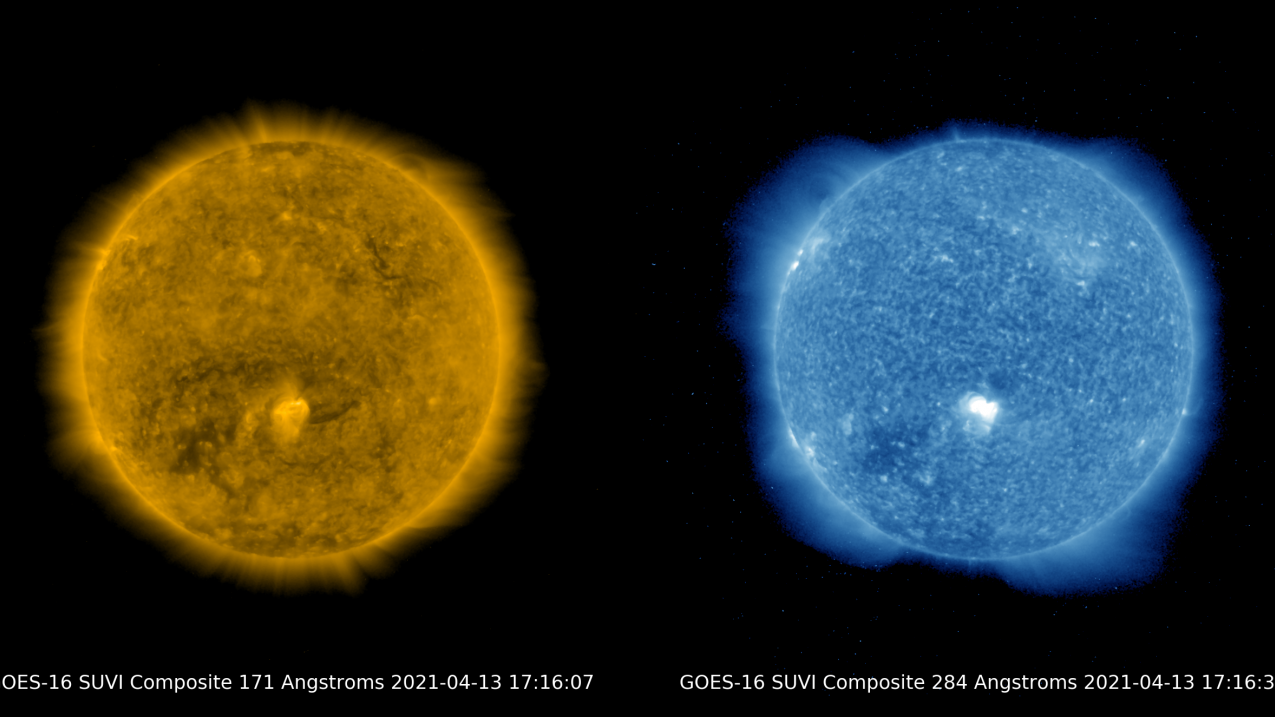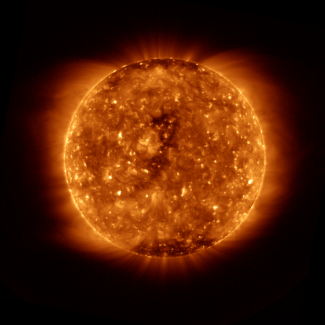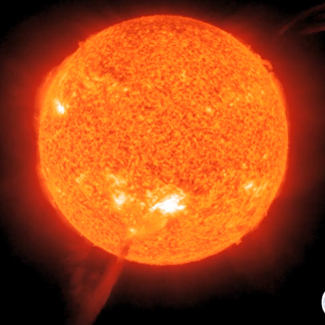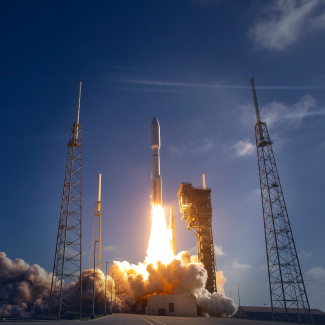Keep exploring
Find even more resources on space weather in our searchable resource database.
Did you know that there are storms always occurring in space? Not rain or snow, but winds and magnetic waves that move through space! This is known as space weather. Sometimes the impact of these storms can reach Earth or Earth's upper atmosphere affecting various technological systems including satellite-based positioning and navigation, high frequency radio communications, and the electric power grid. Rather than the more commonly known weather within our atmosphere (like rain, snow, heat, and wind), space weather can come in the form of radio blackouts, solar radiation storms, and geomagnetic storms caused by disturbances from the Sun.

Two images of the sun from GOES-16 Solar Ultraviolet Imager (SUVI) on April 13, 2021. The image on the left was taken with a 171 Angstrom filter and the one on the right was taken with a 284 Angstrom filter. Different wavelengths of light capture different information about what is happening on the sun's surface and atmosphere. The GOES SUVI captures wavelengths in the ultraviolet spectrum. (Image credit: NOAA Space Weather Prediction Center)
Keep exploring
Find even more resources on space weather in our searchable resource database.
Space weather forecasting
NOAA's Space Weather Prediction Center (SWPC) is the official source for space weather forecasts for our nation. They forecast solar storms, much like other National Weather Service offices forecast weather here on Earth. SWPC forecasters use ground-based instruments and satellites to monitor the Sun for any changes and issue watches, warnings, and alerts for hazardous space weather events. Just like there are categories used to classify hurricanes, there are also Space Weather Scales for communicating the severity of space weather storms. To predict these storms, forecasters watch the Sun for solar flares and coronal mass ejections. Solar flares are massive explosions on the Sun's surface. They often arise near sunspots and release a wide spectrum of photons such as X-Rays, visible light, and ultra-violet light. The biggest solar storms arise from coronal mass ejections (CME). A CME is an enormous bubble of plasma expelled by the Sun; it contains billions of tons of fast-moving solar particles as well as the magnetic field that binds them. The velocity of a CME can even exceed 5 million miles per hour!
The solar minimum between Solar Cycle 24 and 25 - the period when the sun is least active - happened in December 2019, when the 13-month smoothed sunspot number fell to 1.8, according to the Solar Cycle 25 Prediction Panel, co-chaired by NOAA and NASA. We are now in Solar Cycle 25 with peak sunspot activity expected in 2025, the panel said.
Space weather impacts Earth
Earth's magnetic field helps to protect us from the effects of some solar storms, but how can space weather impact the Earth? Strong solar storms can cause fluctuations of electrical currents in space, directly impacting the power grid on Earth and energizing electrons and protons trapped in Earth's varying magnetic field. These disturbances can cause problems with radio communications, Global Navigation Satellite Systems (such as Global Positioning Systems or GPS), power grids, and satellites. Imagine all the ways in which we are dependent upon satellites: cell phones, weather prediction, TV, search and rescue, navigation, space travel, military surveillance, credit card and ATM transactions, and more. What if those satellites were damaged? As we become more dependent on technology, the need for space weather monitoring and forecasting becomes more important.
NOAA’s National Weather Service (NWS) has transitioned a new computer model into operations to increase its understanding of space weather events and improve space weather forecasting capabilities. These advances will help forecasters provide better information to the public about potential impacts from a solar storm and help mitigation actions across economic sectors, including communications, satellite and airline operations, human space flight, and navigation and surveying.
Auroras
They say every storm cloud has a silver lining. In the case of space weather, that lining is the aurora, commonly known as the Northern or Southern Lights. When electrons and protons around Earth are energized by solar disturbances, they can follow Earth’s magnetic field toward the North and South magnetic poles where they collide with atmospheric molecules, energizing the molecules and causing them to glow. The colors that result depend on the types of nearby atmospheric gases and are most commonly a yellow-green color.
The Aurorasaurus offsite link citizen science project helps track where people see auroras. If you happen to see an aurora, consider contributing to the project!
GOES-T will track destructive wildfires, lightning, Pacific Ocean-based storms, dense fog, and other hazards that threaten the U.S. West Coast, Hawaii and Alaska. It will also monitor solar activity and space weather to provide early warnings of disruptions to power grids, communications and navigation systems.
EDUCATION CONNECTION
To address student's questions, educators can use the background information, multimedia, and career profiles. The lessons and activities link the physical science concepts of the electromagnetic spectrum, Earth-Sun relationships, and energy to the engaging topic of space weather. During space weather events students can also track auroras, space weather alerts, solar wind, and satellite imagery of the Sun using the data resources. Visit the Space Weather Prediction Center's education and outreach portal for even more resources!
Keep exploring
Find even more resources on space weather in our searchable resource database.





